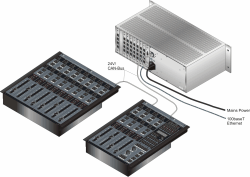Table of Contents
The RM2200D is a flexible and compact digital broadcast mixing system for small and mid-range applications. It is designed from the ground up to be a reliable tool for daily use in On Air studios, OB vans and pre production suites.
A RM2200D mixer consists of two main parts, which are coupled via an industry standard CAN-bus connection (see figure below). These parts are:
The DSP Frame. This 3U rack unit includes all input and output modules, the DSP Audio Engine, the Control Engine and the power supply.
The Mixing Desk. This is the user interface of the mixer with all faders, control knobs, push buttons and displays.
You can order the components of the RM2200D depending on your particular application. When fully configured, the system consists of:
One Master Control module in the mixing desk.
At least one and up to four fader modules in the mixing desk, each containing four faders. This gives you a maximum of 16 physical faders.
One DSP frame which can contain up to 64 inputs and 64 outputs, both analog and digital.
Two stereo main busses, two stereo Aux busses and four stereo clean feeds.
Input processing for eight fader channels. For each channel, this includes three-band equaliser, compressor/expander and variable low- and high pass filters.
GPIO and talkback facilities depending on the modules selected.
![[Tip]](../pics/tip.gif) | Tip |
|---|---|
You can place the modules of the mixing desk both next to each other or apart, as long as the specifications for the CAN bus cabling are met. Depending on the application, this gives you many options to fit the RM2200D mechanically in your equipment setup. | |
The RM2200D uses a special real-time operation system running on dedicated micro controllers. There is no PC-based system inside the RM2200D and it works completely without any PC.
However, to set up and configure the system, you need to connect the RM2200D via Ethernet to a PC running the RM2200D Software. You can also use a serial connection in case no Ethernet is available. You use the software to setup the system for your particular application. This is called Configuration Mode.
Additionally, during daily operation the software can provide extended display functions for the mixer. This mode is called Display Mode and is always active when running the software.
